|
Other
Geoglyphs
South America
The lines at Nazca aren’t the only
landscape figures this region boasts.
850 miles south of Nazca
is perhaps the world’s largest human figure, etched into the
side of Solitary Mountain. The Giant of Atacama at Cerro Unitas
is an incredible 393 feet high and is surrounded by lines
similar to those at Nazca.
In fact there is a copy of this image
at Nazca, although the only place I have seen it mentioned is in Erich von Daniken’s "Arrival of the Gods".
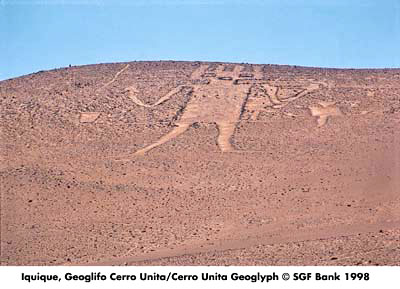 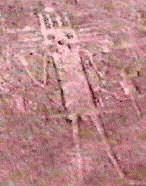
Below are drawings of llamas, with
large images of birds, lizards, fish, crosses, humans and
patterns also appearing in the Atacama desert of northern Chile.
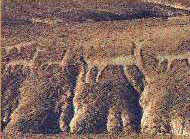 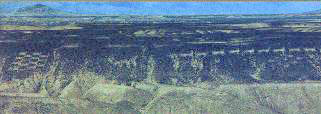
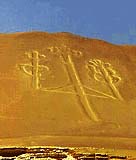 Just
130 miles from Nazca, dug into a sloping hill at Pisco Bay on
the Peruvian coast, this drawing looks very much like a
candlestick - which gives it the name of "The Candelabra of the
Andes". Just
130 miles from Nazca, dug into a sloping hill at Pisco Bay on
the Peruvian coast, this drawing looks very much like a
candlestick - which gives it the name of "The Candelabra of the
Andes".
|
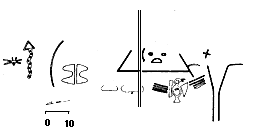
Detail of
Santa Valley, Peru. The scale represents 10 meters.
Ignore the vertical double line - it is not a geoglyph
but rather the azimuth heading of 280-degrees.
|
There has been much speculation about the purpose of the
595 foot high candelabra, but no definitive answer.
It is
constructed in a different manner to the Nazca lines, using
trenches up to one meter in depth, and is best viewed from out
at sea - it can be seen from as far away as 12 miles.
Pottery found near the figure has been carbon dated to 200 BC.
Other, less mysterious lines and
figures have been found within Peru - between the Fortaleza, Pativilca and Rimac valleys, in the Viru Valley (on the
north coast), the Sierra Pintada (the painted mountains) and in
the Zana Valley, over 1,000 km to the north of Nazca.*
And these at Santa Valley (image left)
USA
Along the Colorado river between southern Nevada and the Gulf of
California are more than 200 huge figures. The first to be
discovered was the giant near Blythe, California by a pilot in 1923.
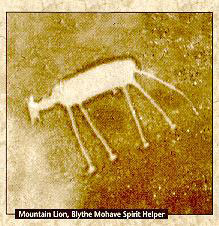 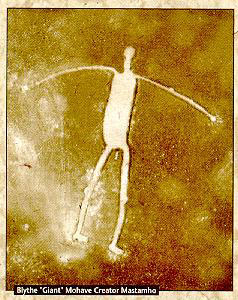
Found just north of Quartzite, Arizona,
is the Bouse Fisherman:
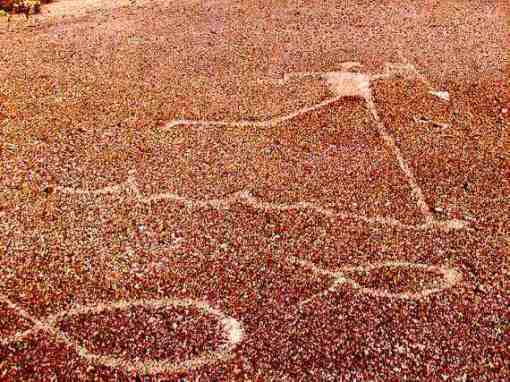
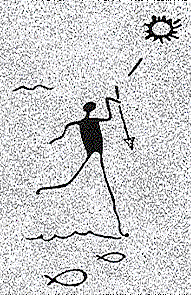
You might also want to check out a
star burst at China Lake,
California, and the
giant of Paradise Valley in
Southwestern Montana that is around 1,287 ft. long with an arm span
of about 330 ft!
England
The English geoglyphs are mostly chalk figures, which require
constant maintenance to stop them disappearing back beneath grass
and soil. This lack of durability means that many others are bound
to have disappeared centuries ago.
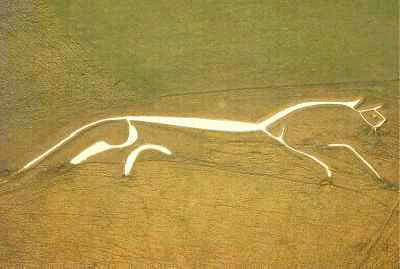 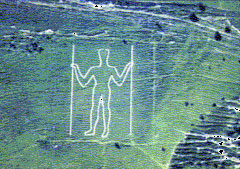
The Uffington White Horse and
the Long man of Wilmington, are
famous. Visit the
Hillfigure Homepage for 41 other
British figures.
Modern
Humans are still busy making geoglyphs, perhaps with more ease than
earlier examples. Australia has a few modern geoglyphs, such as
the Marree Man, constructed in
1998, and 4 kms tall - and
a Giant Wallaby.
You can also check
out another recent one at
Munich Airport.
Go
Back
(*) Wilson, David J.; "Desert Ground
Drawings in the Lower Santa Valley, North Coast of Peru,"
American Antiquity," 53:794, 1988
|




 Just
130 miles from Nazca, dug into a sloping hill at Pisco Bay on
the Peruvian coast, this drawing looks very much like a
candlestick - which gives it the name of "
Just
130 miles from Nazca, dug into a sloping hill at Pisco Bay on
the Peruvian coast, this drawing looks very much like a
candlestick - which gives it the name of "





